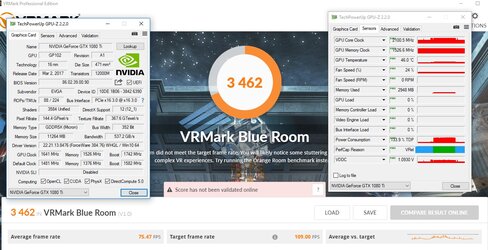- Joined
- Sep 19, 2015
Check Woomack post: the guy is extra seasoned. 2GHz+ is not "common". Under water, yes, but not on air.While the overclocking headroom is likely the same (almost all 1080 Tis can hit 2 GHz), the quality of components / cooling / fan control / aesthetics is different for other cards.
I personally went with the FTW3 because of aesthetics, and the over-engineering of the cooling / power components gives me a little extra piece of mind. I hit 2062 MHz, right in line with everyone else. The switchable BIOS on the FTW3 also gives you some extra power for Precision XOC, and a fail-safe if you're the type to flash BIOS on your cards.
If you only intend to have a 1080 Ti run around 2 GHz with minimal tweaking beyond that, though, the SC Black should be fine. At a certain point, a 1080 Ti is a 1080 Ti, other than aesthetics, noise, and thermals.
Unless you go cold, and then I would agree on lot of phases, the ref PCB is the way to go. And there isn't even a way to mod the bios! This suck big time...
Used to love my 780/780 ti for big bios mod an big boints (heck, used to run a new of my 780ti@1450+ under water, +50% of the core)!
- - - Updated - - -
Check Woomack post: the guy is extra seasoned. 2GHz+ is not "common". Under water, yes, but not on air.While the overclocking headroom is likely the same (almost all 1080 Tis can hit 2 GHz), the quality of components / cooling / fan control / aesthetics is different for other cards.
I personally went with the FTW3 because of aesthetics, and the over-engineering of the cooling / power components gives me a little extra piece of mind. I hit 2062 MHz, right in line with everyone else. The switchable BIOS on the FTW3 also gives you some extra power for Precision XOC, and a fail-safe if you're the type to flash BIOS on your cards.
If you only intend to have a 1080 Ti run around 2 GHz with minimal tweaking beyond that, though, the SC Black should be fine. At a certain point, a 1080 Ti is a 1080 Ti, other than aesthetics, noise, and thermals.
Unless you go cold, and then I would agree on lot of phases, the ref PCB is the way to go. And there isn't even a way to mod the bios! This suck big time...
Used to love my 780/780 ti for big bios mod an big boints (heck, used to run a new of my 780ti@1450+ under water, +50% of the core)!
